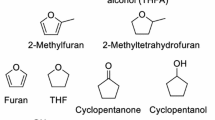Abstract
Xylose was dehydrated over (H+) mordenite, using a continuous two-liquid-phase (aqueous-toluene) plug-flow reactor at 260 °C and 55 atm, with 98% conversion rate, 98% furfural molar yield, and 98% furfural selectivity (results from the first pass). Furfural in toluene was hydrogenated over a Cu/Fe catalyst, at 252 °C (gas-phase), in a 99% conversion rate to give 2-methylfuran in a 98% yield (same activity maintained for a 20-h operation).
Similar content being viewed by others
Explore related subjects
Discover the latest articles, news and stories from top researchers in related subjects.Avoid common mistakes on your manuscript.
1 Introduction
The sequential fractionation of lignocellulosic biomass yields four fractions: extractives (≥90% of theoretical), hemi-celluloses (≥80% of theoretical), lignins (≥80% of theoretical), and cellulose (≥95% of theoretical) [1]. The hemicellulosic fraction comprises mainly C5 and C6 sugars whose ratio depends upon the nature of the biomass For instance, the fractionation of Poplar lignocellulosic biomass (100 wt units, dry basis) by the Feedstock Impregnation and Rapid Sequential Steam Treatment (FIRSST process) gives 5–10 wt units of extractives, 15–20 wt units of hemicellulose, 15–25 wt units of lignin, and about 50 wt units of cellulose [1]. After hydrolysis of the hemicellulosic fraction followed by fermentation of the C6 sugars (95% yield of ethanol), the resulting solution of C5 sugars is concentrated to a 12% w/w solution.
As a way to “valorize” the C5 sugars, we developed selective catalytic processes to convert pentoses (1) to high-octane oxygenates (P-fuels) such as 2-methylfuran (4) (Scheme 1) that can be directly used and blended within the gasoline pool.
We report a high-yield, high-selectivity conversion of xylose (1) to furfural (2) over a (H+) mordenite-type zeolite, in a two-liquid phase (aqueous and toluene) plug-flow reactor [2] (Fig. 1), and the selective and efficient heterogeneous catalytic vapor-phase hydrogenation of furfural (2) to 2-methylfuran (4) at P = 1 atm (Fig. 2).
Recently, the HCl dehydration of fructose to 5-hydroxymethyl-furfural in a biphasic reactor (H2O + NaCl/butanol at 180 °C) followed by vapor-phase hydrogenolysis of HMF to 2,5-dimethylfuran has been reported [3].
2 Experimental Section
2.1 Analytical Methods
The yield of furfural (2) and 2-methylfuran (4) was determined by VPC (Agilent 6890 chromatograph, FID detector, column Agilent 19091 J-41 3HP-5) using an internal standard. The aqueous phase was analyzed for unreacted sugar by HPLC (Dionex DX-500, pulsed amperometric detector, Dionex Carbopac PA10 column, 20 mM NaOH as eluent) with an internal standard.
2.2 Zeolite Catalyst
Protonation To the zeolite (2.6 g) suspended in water, phosphoric or sulfuric acid was added until the pH reached 2.3–2.5 (final volume 200 mL). Regeneration The wet-oxidation unit [4] was a batch reactor operated at a temperature of 200 °C. The residence time was 2 h. Pressurized (27 atm) air flow and agitation permitted a continuous bubbling of air in the zeolite aqueous suspension. Then, the water-catalyst phase was re-impregnated with the acid as described above.
2.3 Dehydration of Xylose (1)
The initial xylose (Sigma-Aldrich, purity of 99%) containing aqueous solution (1–12% w/w) was mixed with the protonated zeolite (zeolite/sugars 2:98 w/w) and was emulsified with toluene at the entrance of the plug flow reactor shown in Fig. 1. The reactor (zirconium pipe 1.06 cm × 100 cm) was heated continuously with water vapor, and pressurized to 55 atm with nitrogen to ensure that the reaction took place in the liquid phase. The residence time of xylose in the reactor was between 1.5 and 10 min. The organic phase/aqueous phase volumetric flow rate ratio was between 1 and 5. The biphasic reaction mixture was recovered in a water-cooled tank and the aqueous-catalyst phase was decanted from the furfural-solvent solution by gravity separation. Under the best conditions (260 °C, t = 3.0 min, 10–12% w/w xylose solution, catalyst/sugar weight ration of 2.0), the efficiency of furfural extraction in toluene was 95–98%.
2.4 Hydrogenation Catalyst
Preparation A solution of 30–70% (w/w) Cu(NO3)2 and 70–30% Fe(NO3)3 was treated with a 1 M solution of (NH4)2CO3 under vigorous stirring. The paste obtained was dried at 120 °C for 12 h, crushed in a mortar, then sieved (0.3–1.2 mm particles used). For catalysts supported on silica, SiO2 (50% by weight of Cu(NO3)2 + Fe(NO3)3) was added to the solution. The silica used was Silycycle Ultra Pure silica gel (220–240 mesh, 200 m2 g−1, pore diameter 69 Å). The sieved catalyst (0.3–1.2 mm) was heated to 550 °C for 4 h then reduced with H2 at 270 °C until no water was evolved. The reactor (Fig. 2) was filled with 100 mL of the catalyst. Regeneration The used catalyst was treated with water vapor at 250 °C, then heated to 550 °C in air and finally reduce by H2 at 270 °C.
2.5 Hydrogenation of Furfural (2)
Furfural in toluene (0.64 M solution) was hydrogenated in the vapor phase at P = 1 atm in the heated reactor shown in Fig. 2 filled with the powdered catalyst under the following conditions: Toven = 200–290 °C; Treactor = 240–280 °C; gas flow = 48 h−1; H2/2 mol ratio = 5. The reaction mixture was then cooled down, collected in the methylfuran tank, and analyzed.
3 Results and Discussion
3.1 Dehydration of Xylose to Furfural (2)
High acidity, high reaction temperature, contact with air oxygen, and long residence time contribute to polymerization and oligomerization of furfural to give furanic resins decreasing the pentose dehydration selectivity [5]. In order to minimize those side reactions, the dehydration was carried out in the two-liquid-phase plug- flow reactor shown in Fig. 1. The pentose aqueous phase was mixed with protonated zeolite and intensely mixed with toluene, a solvent which has poor solubility in water while having high affinity for furfural (2). In such a system, furfural (2) is extracted from the aqueous phase as soon as it is formed, which minimizes its contact with the acidic catalyst and the formation of furanic resins [5]. Different parameters were varied in order to optimize the furfural (2) yield and selectivity. Four zeolites (zeolite SM-25, mordenite 13 (Si/Al = 13), mordenite 20, faujasite 13) were investigated. The zeolite was treated with H3PO4 or H2SO4 at a pH of 2.3–2.5. The best results were obtained with mordenite 13 acidified with H3PO4. The effect of temperature, that of xylose concentration, of catalyst/sugar weight ratio, of toluene/xylose aqueous solution volumic ratio, and of flow rate (residence time) were also studied. The best conditions were: powdered mordenite (H+) 13 as catalyst, 12% w/w xylose solution, reactor temperature of 260 °C, pressure of 55 atm, toluene/xylose aqueous solution volumic ratio of 2, residence time of 3 min. Under those optimal conditions, the efficiency of furfural extraction was 95–98%. The conversion rate was 99%, the furfural (2) molar yield 98%, and the selectivity 98% after a first pass. After a second pass, the conversion rate was 98%, the furfural (2) yield 90%, and the selectivity 89%. The used mordenite was regenerated by wet oxidation as described in the Sect. 2, the organic matter in the pores and on the surface being eliminated by air oxidation. The mordenite was then re-impregnated with phosphoric acid. Dehydration of xylose using the regenerated protonated zeolite was carried out under the same conditions as those given above and gave, after a first pass, a conversion rate of 98%, a furfural (2) yield of 90% with a selectivity of 89%. Thus, the regeneration of the mordenite did not fully restore completely its original activity.
3.2 Hydrogenation of Furfural (2)
A Cu–Zn–Al Ca–Na (59/33/6/1/1 w/w) [6] and three Cu–Fe (30/70, 50/50, 70/30 w/w) catalysts were tested in the hydrogenation reactor shown in Fig. 2 under different conditions of temperature, pressure, and flow rate (see Sect. 2 for the catalysts preparation and hydrogenation procedure). Toluene was not hydrogenated. Under the best conditions (Cu/Fe 50/50 w/w precipitated with (NH4)2CO3, calcinated at 550 °C and supported on SiO2; Toven = 265 °C; Treactor = 252 °C), the conversion rate was 99% and the yield of 2-methylfuran (4) was 98%. Only 1% of 2-hydroxymethyl-furan (3) was formed. The catalyst activity dropped after 20 h of operation. The recovered catalyst regenerated as described in Sect. 2 was much less active giving 29% of 2-hydroxymethyl-furan (3) and 55% of furfural (2) with a 99% conversion rate (16% loss).
4 Conclusions
The above results show that xylose can be dehydrated to furfural (2) in very high yield and selectivity (98%) in a two-liquid -phase plug-flow reactor under mild conditions using a mordenite (H+) catalyst but with some loss of catalyst activity. A cheap Cu/Fe catalyst was designed which could achieve the selective hydrogenation of furfural (2) to 2-methylfuran (4) with 98% selectivity but with a marked loss of activity after 20 h. The hydrogenolysis of 2-hydroxymethyl-furan (3), formed first by hydrogenation of the carbonyl group of furfural (2), to 2-methylfuran (4) without hydrogenating the furan ring is noteworthy. Work is in progress to find conditions to regenerate the catalysts to their initial activity.
References
Montane D, Farriol X, Salvado J, Jollez P, Chornet E (1998) J Wood Chem Technol 18:171
Montané D, Salvadó J, Carles T, Farriol X (2002) Biomass Bioenergy 22:295
Román-Leshkov Y, Barrett GJ, Liu ZY, Dumesic JA (2007) Nature 447:982
Stüber F, Polaert I, Delmas H, Font J, Fortuny A, Fabregat A (2001) J Chem Technol Biotechnol 76:743
Choura M, Belgacem NM, Gandini A (1996) Macromolecules 29:3839
Zheng HY, Zhu YL, Bai ZQ, Huang L, Xiang HW, Li YW (2006) Green Chem 8:107
Acknowledgments
Financial support from NSERC and Enerkem Technologies Inc. is gratefully acknowledged. We are thankful to Mr. Henri Gauvin for his very important contribution and Dr. Jean Marc Chapuzet for his very valuable input.
Author information
Authors and Affiliations
Corresponding author
Rights and permissions
About this article
Cite this article
Lessard, J., Morin, JF., Wehrung, JF. et al. High Yield Conversion of Residual Pentoses into Furfural via Zeolite Catalysis and Catalytic Hydrogenation of Furfural to 2-Methylfuran. Top Catal 53, 1231–1234 (2010). https://doi.org/10.1007/s11244-010-9568-7
Published:
Issue Date:
DOI: https://doi.org/10.1007/s11244-010-9568-7







